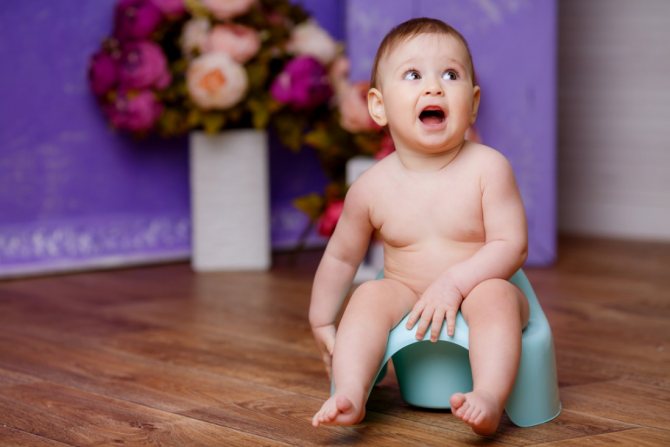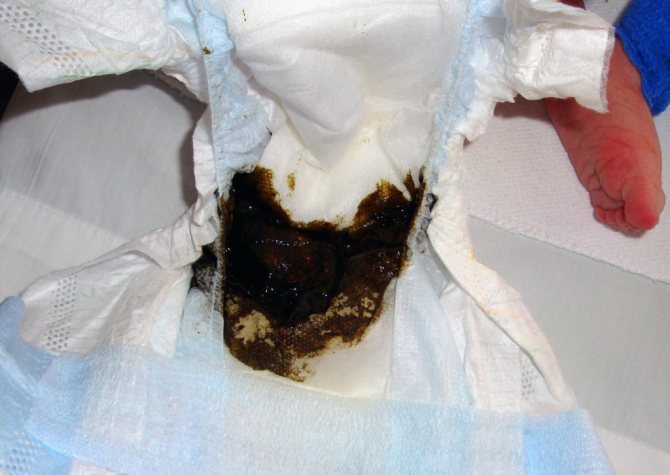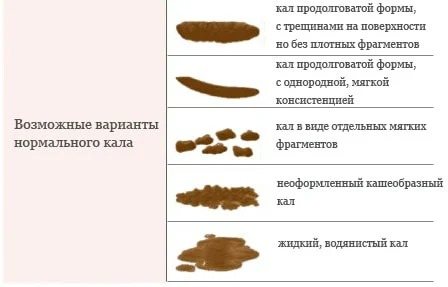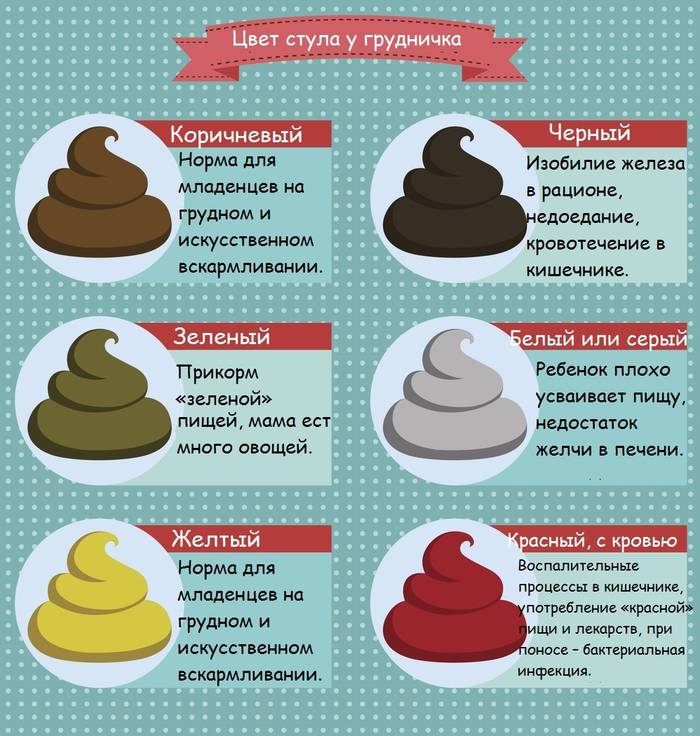Komarovsky's opinion on the children's chair
No matter how strange it may sound, a child born at term is often called premature (however, this can be called all children).
Despite the fact that the baby spent all 9 months under the mother’s heart before being born, his body is not at all strong. The organs have yet to fully develop, and this takes time. Usually, the formation of the organs of a breastfed child does not raise any questions; everything is provided for by nature. It is much more difficult to monitor the health of a baby who is fed infant formula. Artificial feeding cannot be called ideal, because the components contained in the formulas are not always suitable for the baby, provoking the child’s body to different reactions.
Often, young mothers note the appearance of green stools after transferring the child to artificial feeding.
Mothers often worry about what kind of stool their babies have: frequent, rare, liquid, hard, etc. According to Dr. Komarovsky, parents are too sensitive to this issue, examining children’s poop literally under a magnifying glass. This is not at all necessary, given that the nature of a newborn’s stool changes frequently, and the concept of normal in this case is very relative.
The main thing to remember: if changes in stool occur against the background of a deterioration in the child’s condition, then you need to consult a doctor. If the baby feels well (is active, gaining weight), then there is no reason to worry. There is no need to drag your baby to the hospital if the situation does not require it.
"Children's advice" by Dr. Komarovsky
This does not affect his condition and activity in any way, his appetite is good, his sleep is also good, there are no seething or excessive gas formations. The test for dysbacteria lacks bifidobacteria and lactobacilli, and recently they tested for coprogram and found yeast fungi, moderate extracellular starch, and moderate iodophilic flora. The discovery of yeast fungi worries me; he puts everything in his mouth both on the street and at home. Is it worth doing additional? If it weren’t for mushy stools once or twice a day, I wouldn’t worry, the child feels good. And is it still possible to get the Pentaxim vaccine one of these days? We’ve already delayed the deadline, I was sick. Answer from N. Basalaeva: Dear Lydia, the appearance of yeast in the stool may be due to: 1. Before repeat coprogram, I would not recommend getting a vaccination - a consultation with a gastroenterologist is necessary.
Whatever the baby's stool is - liquid or mush-like, yellow or greenish, with or without a pungent odor, all this falls within the normal range. How often your baby poops and what the stool looks like depends on many factors, including age, diet, diseases, and heredity.
What should it be like normally?
The color of the stool of a breastfed baby is often yellow, but may have a greenish or mustard tint, as well as impurities. The consistency of such a child’s stool is normally similar to gruel or thick sour cream. A liquid consistency is also possible; the stool may be foamy and have a sour odor.
The color of the stool of a breastfed baby can be influenced by the following factors:
- physiological immaturity of the digestive tract and lack of enzyme production;
- hormone content in mother's milk;
- oxidation of stool when exposed to air;
- taking medications by the baby or mother;
- mother's nutrition.
When a baby is born, its organs and systems are not yet formed. This can lead to various problems, for example, changes in stool, which often cause parents to panic. This may be a green tint to the stool.
If the baby is bottle-fed, there are more reasons for concern, so you need to figure out what could be causing this phenomenon.
In matters of children's health, there is always the concept of a certain norm that everyone is guided by. But there is no norm as such regarding a child’s stool. It can be anything, and if the baby has no signs of pathology, there is no need to panic in advance.
Before complementary foods are introduced, stool is usually liquid. In artificial plants it is characterized by greater density and uniformity.
The appearance of green in the stool usually worries mothers, although it may not be associated with any pathology. The reasons for this phenomenon differ depending on the type of nutrition, so it is worth considering them specifically for artificial babies.
The most common reason is nutrition. The baby’s body is not yet formed, so problems may arise with digesting food.
The stool of a formula-fed newborn may be accompanied by mucus and may be green due to the increased iron content in the mixture. In such cases, it is usually enough to replace the mixture, and the situation will return to normal.
There may be changes in feces when transferring the baby from natural to artificial feeding. Sometimes the body needs time to adapt, and then everything will be fine.
And sometimes green stool in a formula-fed baby is a side effect of taking certain medications.
A common phenomenon at the beginning of life is dysbiosis. It appears when the necessary microflora is formed in the intestines.

At this time, the activity of pathogenic microorganisms increases, which can change the consistency and color of stool. Usually, when the microflora is formed, the bowel movements also return to normal.
However, the reasons for a change in stool color may be more serious. Perhaps we are talking about intestinal infections, congenital problems of the gastrointestinal tract, weakened immunity, enterocolitis, lactose deficiency, and so on.
To understand the exact cause, you need to analyze additional symptoms and show your baby to the doctor.
People often ask: how to bottle feed a baby correctly? You asked - we answer!
You can learn about what vaccinations children under one year old are given in our article.
This article will tell you how to dilute Bifidumbacterin powder for a newborn.
There is a certain period when the green stool of a formula-fed baby should not cause any concern. This period is a natural process and lasts about five days after birth.
The initial stool of a newborn is always green in color. This is due to the fact that in the first days after birth the body tends to free itself from swallowed epithelial tissue, amniotic fluid, etc. This way the intestines are cleansed.
Gradually, around the fifth day, the baby’s stool should undergo noticeable changes:
- white curd pieces of undigested milk mixture may be found in the stool;
- The color of the stool changes to yellow-green, which should gradually become completely yellow or mustard.
However, there are exceptions to all rules. There are cases when a baby has green stool with mucus, indicating that the digestive system is not yet fully formed and does not have enough enzymes to properly process food.
Sometimes dark green stool can cause bilirubin to leave the body. This is also a fairly ordinary process that can be characterized by these changes.
In a formula-fed newborn, green stool may be a common reaction to the formula being consumed. This is especially facilitated by a diet with a high iron content in its composition. In a five-month-old baby, a greenish tint to the stool may be a consequence of the introduction of the first complementary foods, or the beginning of the eruption of the first teeth.
Not a single practicing pediatrician will tell you this notorious norm. Ideally, the stool should be yellow and mushy with a slight sour odor; this is even described in medical books. In fact, the color of feces depends on many indicators. And from the method of feeding (breastfeeding, artificial or mixed), and from the composition of the nursing mother’s milk, from what she ate.
We suggest you read: A child has Komarovsky fungus on his feet
And in the first two to three days after birth, the newborn’s stool is dark green or black; this is the original meconium, which consists of amniotic fluid, particles of bile and mucus, and epithelial cells. In this case, there is no need to panic, this only means that the child’s intestines are functioning fully, and as a rule, after a week, the feces begin to acquire the usual color - from light yellow to mustard.
What should a normal stool look like?
At different stages of development, the baby's stool changes from a liquid, unnatural color to a fraction characteristic of each person. Parents must be sure to monitor the frequency, consistency, color and presence of odor in the child’s discharge.
During this period of a little person’s life, the accumulation of remnants of amniotic fluid that entered the body at birth, intestinal epithelial cells, bile, mucus, etc. occurs in his intestines. Such feces are called original feces or meconium.
The discharge has a black, dark red or olive tone, a resinous structure and is odorless. Green stool in a newborn is not due to the bacterial nature of its formation. The appearance of discharge is the first sign of normal functioning of the gastrointestinal tract.

During the first two to three days, a breastfed baby’s body completely absorbs the mother’s colostrum, so feces are not formed.
The baby's intestinal system is developing due to changes in the composition of the nursing mother's milk and the formation of bacteria in the digestive tract.
The process occurs in two stages:
The baby's stool has the appearance of a paste, thick sour cream, the color is predominantly yellowish, with rare splashes of green (residual effects of meconium). The presence of a white mass and small amounts of stool with mucus in an infant is not a deviation. Changes in the appearance of feces occur under the influence of bacteria in the gastrointestinal tract.
The discharge takes on a dark green color with a transitional gray tint, and has a porridge-like consistency. Initially, the frequency of bowel movements is about ten times a day, and as you get used to breast milk, the frequency of bowel movements decreases to one or two times over three to seven days.
This is due to the complete absorption of the beneficial substances of breast milk in the infant’s gastrointestinal tract. It is necessary to strictly monitor meconium in the stool: if its presence in the stool is observed on the fifth day, you should consult a doctor. Artificial feeding can affect the structure of stool.
The baby's stool takes on a light brown, mustard color. The consistency of the mass is mushy. Green, liquid stool in a baby or constipation indicate the occurrence of abnormalities.
At the stage of feeding the baby with breast milk, the stool is normally mature. The waste products of a baby can be light brown, grayish and even green. The feces of a month-old baby on breastfeeding should be of medium density: neither liquid nor solid.
Greens in children on mixed and artificial feeding
If a bottle-fed baby has green stools, perhaps the mother should reconsider the baby’s diet. This can happen due to a change in the adapted mixture, due to taking antibiotics or iron-containing dietary supplements. And if you consume a mixture enriched with iron at the same time, the green color of the stool is guaranteed.
In addition, hypoallergenic artificial mixtures with complete breakdown of cow protein during digestion always produce brown-green stool. If you are satisfied with the mixture in everything else except the color of the stool, then it is not advisable to change it.

When complementary foods are introduced, the baby's gastrointestinal tract can react in such a way that the feces become thick and may have a greenish tint. However, during the process of adaptation, the baby's intestines will adapt to new foods and over time the color of the stool will become normal.
Mixed-fed babies eat mother's milk and formula, so green stools are even more common in them. The cause of greenness can be either mother's milk or formula. Therefore, before drawing any conclusions regarding the baby’s well-being, watch him; perhaps there is no reason to worry.
Parents closely monitor changes in the color and consistency of children's feces. This is not surprising, because a newborn’s bowel movements can indicate various diseases.
The norm is yellowish (brownish) color of stool with a liquid consistency. Over time it changes. Usually the color of the bowel movements becomes somewhat darker, but some parents note that the child’s stool has become green.
The reasons for this phenomenon may be the following factors:
- transferring a child from breastfeeding to artificial feeding (if the baby’s stool turns green at the time of transfer to a new diet, you should wait a while, perhaps the body will adapt to the new “menu”);
- unsuitable milk formula (to fix the problem you need to change the brand of food to another);
- introduction of new food products (usually broccoli, zucchini and other baby purees give baby stool a green color);
- treating the child with medications (green bowel movements in this case are a side effect);
- symptom of a disease (for example, dysbiosis).
In the latter case, the child may require treatment.
Only the attending physician can tell you how to properly treat a child, and only after an in-person examination.
The fact is that green stool can be a sign of a variety of diseases. Often, green stool (namely, diarrhea) is a sign of dysbiosis. In this case, the doctor will prescribe individual treatment. For example, Linux and dieting.
Causes of green stool in infants
Green poop in a breastfed newborn may be a symptom of serious changes. The baby may have hereditary and acquired pathologies of the digestive system, as well as enterocolitis (synchronous inflammation of the large and small intestines), and dysbiosis.
Possible causes of changes in stool color include:
- helminthiasis (parasitic infection),
- lactase deficiency,
- allergic reactions,
- excess bilirubin,
- severe and prolonged diarrhea.
In addition, green poop in infants can occur as a result of an undeveloped immune system or infectious diseases. The reasons for this deviation in bottle-fed and breastfed children are considered separately.
Artificially fed
Green stool in a formula-fed baby is a common deviation. The child faces difficulties in obtaining vitamins, micro- and macroelements, and therefore the likelihood of dysbacteriosis and worsening immunity increases. Such deficiencies can be prevented by gradually introducing nutrient mixtures with probiotics and prebiotics into the diet. Preparations for prevention, including bifidobacteria and lactobacilli, will be useful.
Green stool may occur in an infant if the composition of the formula used is not suitable for the baby. In such a situation, parents should find a more suitable option as soon as possible.
A change in the shade of stool may occur due to a specific reaction of iron (usually present in artificial nutrition). This is most clearly diagnosed in newborns with lactose dysfunction.
Breastfed
When breastfeeding, green stool can be considered normal for a baby. The fact is that in the first months of life, this color of stool, in the absence of alarming symptoms, is most often the norm. There can be many reasons for these changes, for example, the mother’s hormonal instability after childbirth, or her transition to a new diet.
Green poop in a newborn baby occurs if a woman eats a lot of foods. This can be fresh vegetables and fruits, dill, parsley and other greens.
Gradually, such a diet leads to the fact that the baby’s stool turns a similar color. However, this is not dangerous for the child; you can get rid of it by changing the mother’s menu, if possible (after all, with certain diagnoses, this may be a mandatory diet after childbirth).
When talking about the reasons for green stool in a child, pay attention to the fact that:
- at the age of four months, a change in the color of the stool may indicate premature introduction of complementary foods,
- the color and consistency of stool is largely influenced by the regularity and correctness of the baby’s attachment to the breast,
- receiving colostrum instead of milk (formed if the baby does not completely empty the breast) provokes liquid green stool (diarrhea) in the baby, sometimes along with mucus.
The influence of nutrition of a nursing mother
The baby's stool may turn green and become liquid if there are sudden changes in the mother's diet. Mom should introduce new food products into her menu very carefully. You should eat well, paying attention to the process of cooking. Spicy, fried and fatty foods in a mother's diet can affect the stool of a breastfed baby. A nursing mother should get protein from lean meat, dairy products, poultry and fish. You should not consume cow's milk (whole milk) in large quantities, as it is an allergenic product.
Mommy's diet should include dietary fiber from vegetables and fruits. At the same time, it is recommended to avoid red and orange fruits. A nursing mother should not eat exotic fruits.
Should I go to the doctor?
Changes in feces are often a physiological phenomenon, or provoked due to certain reasons. However, it is not uncommon for the color of a baby's feces to be a sign of illness.
The child should be shown to a doctor if, along with a change in stool, other changes were noticed (including in the child’s behavior):
- baby's restless sleep;
- frequent regurgitation or vomiting;
- an admixture of blood in the stool or grains of unknown origin;
- crying/tantrums for no reason;
- the smell of feces is foulbrood;
- increased body temperature;
- skin rashes;
- diarrhea;
- signs of a cold or acute respiratory viral infection.
Usually, when parents notice the signs mentioned above along with green feces, the question arises: what to do? First of all, contact a specialist!
If there is any suspicion of a deviation from the norm, you should show the child to a pediatrician. He will examine it, prescribe the necessary examinations and then determine the cause and prescribe the necessary measures.
Go to a specialist if you notice the signs listed above.
If signs of “hungry stool” are detected, there is no reason for an urgent medical examination. First you need to establish the cause of malnutrition, and then try to eliminate it. For example, if the lack of nutrition arose due to the baby not receiving fatty (“hind”) milk, it is necessary to ensure that the breast is latched correctly.
To do this, you need to keep the baby on one breast for as long as possible (until he releases it himself). If this does not help, then most likely you will need to switch to mixed or completely artificial nutrition. It is also recommended to have your diet reviewed and adjusted with the help of a lactation consultant.
Important! If there are signs of dehydration and rapid fatigue of the baby, urgent medical attention is needed.
Stool in babies can be different - the characteristics depend on numerous factors, the most important of which are the type of feeding and the age of the baby. The concept of normal stool covers many signs and characteristics, and therefore is very vague. “Hungry stool” in a baby is one of the types of deviations from the norm, which indicates a lack of nutrition for the newborn. You can correct the situation yourself or with the help of a breastfeeding consultant (medical intervention is necessary only in extreme cases).
Symptoms of an unhealthy baby with green stools

If you notice green stool in your baby, you need to constantly monitor his condition. If the newborn’s behavior has changed dramatically, he has become more whiny, capricious, and has begun to refuse to eat, then you should immediately consult a doctor.
Green stools that cause alarm and concern should look like this:
- green stool foams and has a strong unpleasant odor;
- frequent green stools with a liquid consistency;
- green stool with black speckles that has a rotten odor;
- slimy green stool combined with a sharp deterioration in the baby’s well-being;
- green stools with bloody or speckled discharge (usually seen with constipation).
We invite you to familiarize yourself with what foods are not allowed during breastfeeding.
When the stool has a foamy green consistency, it may indicate a lack of nutrients or vitamins in the newborn. Breastfed children often experience a lack of so-called colostrum. This can cause a deficiency of elements necessary for the body.
The unpleasant smell of green feces can be a herald of the onset of the inflammatory process. And stool with blood specks indicates a serious problem with the digestive system, or a violation of the integrity of the intestinal lining. If these symptoms occur, contacting a qualified specialist is considered necessary.
You should be attentive to other signs of an unhealthy baby:
- increased weakness and drowsiness;
- tearfulness;
- refusal to eat;
- constant pressing of the legs towards the abdominal area;
- sudden weight loss;
- nausea and gag reflex;
- colic and pain;
- temperature;
- diarrhea;
- difficulty with bowel movements;
- rash;
- allergic reactions on the skin;
- flatulence.
What to do if you have green stools?
If your stool appears green, the following actions are recommended:
- Ensure that the baby is properly attached to the breast, allow him to get enough and complete breastfeeding on his own.
- Make breastfeeding regular, depending on the body's needs.
- Control your diet during breastfeeding, avoid artificial additives and exotic foods.
- Treat the baby's intestinal dysfunction under the supervision of a doctor.
- Don't worry if your stools turn green after taking Smecta.
- Thoroughly study the composition of artificial complementary foods, ensure optimal selection for the baby’s body (for example, use NAN mixtures).
- Green stools without accompanying warning signs are normal and do not require intervention.
- Use of additional nutrition in due time.
- Dr. Komarovsky can give an online consultation on his website.
- The frequency of green stools in combination with alarming symptoms is a necessity for seeking medical help.
Green stool in a newborn during breastfeeding is not always a deviation. If your child is developing normally, cheerful and active, there is no need to worry once again about why the child has green stool and tirelessly torment the child with visits to the doctor.
Control your diet during breastfeeding, provide your children with proper care, monitor their behavior, and then there will be much less cause for alarm.
Diagnostic methods
Green stool is not always a cause for concern. If the baby sleeps peacefully, eats with appetite, and his behavior and appearance do not cause suspicion, there is no need to take any action. But changes in stool along with other symptoms require immediate treatment.
There are young mothers who consult with doctors online: they send a photo of the newborn’s stool and describe its symptoms - this diagnosis does not provide guaranteed results.
In order to establish the presence (or absence) of the disease, you need to contact your pediatrician. At the doctor's appointment:
- Examine the child;
- Will give a referral for a blood test;
- He will ask you to test your stool (and possibly urine).
Only after the test results will a conclusion be made about the baby’s health, as well as the need for treatment.
If you suspect any problems, you must undergo appropriate tests.
Coprology will help determine the causes of violations. It detects different types of infections when present.
A bacterial culture will also be required. This measure helps to characterize the intestinal microflora.
Additionally, blood and urine tests may be required. Based on the research results, the doctor will prescribe the necessary measures.
Possible reasons
Dysbacteriosis
This is not a disease, but a disturbance in the composition of the flora inside the baby’s intestines. The number of bacteria that should normally be smaller in the intestine increases, and, accordingly, the number of bacteria that should normally predominate decreases.
In babies who receive only breast milk, dysbiosis may appear as a result of supplementation. Although, even in those children who are not given additional water, a state of dysbiosis is possible, since the baby’s intestines are immature and its flora is only being formed after birth.

With this pathology, the baby's stool is foamy and green in color. The diagnosis of deficiency of this enzyme is quite rare. More often, stools of this color and consistency indicate that the baby is feeding mainly on foremilk (watery and liquid).
When changing a baby's diaper, parents always need to pay attention to its contents. After all, this is an important indicator that can tell a lot about the state of your baby’s health, especially if the child is bottle-fed. In this case, the child’s intestinal functioning changes, and, consequently, noticeable changes occur in the feces.
If the color of the stool is unnaturally yellow or orange, this may indicate liver problems. Green stool is an indicator of various types of dysbiosis. Therefore, if you notice any changes in your baby’s stool, you should immediately contact a specialist.
The reasons for a baby's green stool can be completely natural and not cause concern, or they can pose a huge threat to the health of the newborn.
The most common cause is nutrition. The digestive system of an infant is not yet able to work at one hundred percent. Therefore, problems with digesting food often arise. In this case, green stool may be accompanied by mucus. To normalize a newborn's bowel movements, simply changing the formula is often sufficient.
Also, every baby at the beginning of his life is faced with a problem such as dysbiosis. It occurs when the intestines form the necessary microflora. This period is characterized by an increase in the development of pathogenic bacteria, which can change the color and consistency of the baby's stool. The bowel movements will return to normal when the microflora is fully formed.
Serious causes of green stools when a baby is bottle-fed can be:
- rotavirus or fungal infections;
- congenital disorders associated with the gastrointestinal tract;
- weak immunity;
- lactose deficiency;
- allergic reactions;
- enterocolitis;
- diarrhea, etc.
What to do?
If, apart from the change in the color of the stool, everything is fine with the child (sleep, mood and appetite are normal), just monitor the baby’s condition and at the first warning signs, take the baby to the pediatrician.
To ensure that the baby receives milk from the posterior chamber of the breast, give the baby the breast on demand and do not supplement it, so as not to reduce the baby’s desire to suckle. It is also important to ensure that the baby’s position when sucking at the breast is correct.
If there are suspicions that the greens in the diaper are caused by some products on the mother’s menu, you should try to exclude them from the mother’s diet.
Preventive measures
To avoid problems with bowel movements, a young mother needs to carefully monitor the nutrition of her newborn. If the milk formula chosen for artificial feeding causes side effects in the child, find a suitable replacement.
If you have already started introducing complementary foods, pay attention to changes in your baby's stool. Often, baby puree can color stool in different colors: green, red, with a dash of white. Introduce new products gradually.
Fresh air is good for children's bodies, so take your child for walks in the parks more often.
An attentive mother will always notice that something is wrong with her child. Even if there are no obvious reasons for alarm. The mother's heart will feel that the baby needs help. Love your children, give them affection and warmth, then they will get sick much less often.
The main prevention of problems with stool is careful monitoring of the baby’s nutrition. If negative reactions are noticed when consuming one or another mixture, you need to replace it with another, more suitable one.
It is necessary to introduce new products into the baby’s menu carefully and gradually.
It is also worth taking care of the general strengthening of the child’s body, for example, taking him for walks in the fresh air more often. Be sure to undergo examinations for preventive purposes.

The sooner a particular health problem is identified, the faster and more successfully it will be treated.
Green stool in a formula-fed baby is not a reason to panic. But even if it is accompanied by other suspicious manifestations, you should not ignore it. A visit to a specialist will always answer your questions.
Do you like the article? Rate and share with friends on social networks!
In order to make your child feel better, you need to take certain measures if you have green stool.
Firstly, it is recommended to get tested immediately. Coprology will help identify the causes of the violation. By examining a child's stool, various types of infections can be identified.
We invite you to familiarize yourself with Cookies for 1-year-old children and infants: recipes, when to give them
Secondly, bacterial culture is required. This analysis characterizes the state of the intestinal microflora.
The most important thing in such a situation is not to self-medicate. Otherwise, you can worsen your child's health. You should also monitor the newborn's nutrition and his reaction after each meal.
Folk remedies for constipation
Many mothers try to help their child with the help of recipes that their grandmothers used. They push a piece of soap, a cotton swab coated with Vaseline, or a thermometer into the baby’s anus. This is how constipation in an infant was often treated in the past. Komarovsky warns parents against using such means. He believes that this is child abuse. In addition, such drugs can injure the mucous membrane, cause irritation in the anus and further aggravate the problem.
Among folk remedies, the doctor prefers decoctions that help remove gases. It is best to brew dill seed, anise or fennel. Komarovsky considers raisin decoction very useful. In addition to its laxative effect, this drink enriches the body with potassium, which is very important for normal intestinal function. There is a greater choice of remedies if a baby has constipation for 6 months. Komarovsky recommends giving your baby juice, decoction or puree of prunes, and including foods rich in fiber in the diet.
When this color is a sign of digestive problems or infection
Sometimes green stool is quite normal. However, in some cases he speaks of serious violations.
Among the alarming symptoms of green stool are the following:
- green stool in a bottle-fed baby foams and has a strong unpleasant odor;
- green stools are loose and frequent;
- black spots with a putrid odor are noticeable in the stool;
- along with changes in bowel movements, there is a clear deterioration in the baby’s condition;
- In the green stool of a bottle-fed baby, mucus, bloody discharge or inclusions are noticeable.
- the child is crying, he is very weak, constantly wants to sleep;
If the consistency of green stool in a bottle-fed baby is foamy, this may indicate a lack of vitamins and other necessary components in the body.
If the stool has a strong, unpleasant aroma, this may indicate the onset of inflammation.
There are other symptoms that, in combination with green stool, indicate that the baby is unwell:
If a change in the color of the stool is accompanied by a change in the child’s behavior, if he is capricious, eats poorly and has an elevated body temperature, then it is quite possible that there is an infection or tummy problems.
This condition is typical for all newborns whose gastrointestinal tract is just beginning the process of formation. The baby's intestines are gradually populated by beneficial microflora and any intervention (for example, regular supplementation with water) can upset the delicate balance of beneficial and pathogenic bacteria, causing dysbiosis.
In addition to green diarrhea, a baby with dysbacteriosis may develop a rash and frequent regurgitation. A problem of this nature can be easily corrected; it is enough to do a laboratory analysis of stool. And the pediatrician will select the necessary medications for the baby with beneficial bacteria.
If a baby has green diarrhea with mucus, this may indicate lactase deficiency. The child does not absorb hindmilk enough and gets intestinal upset. An additional sign of lactase deficiency is that the child simply does not gain weight.
Diarrhea can be provoked by a “tooth test” of everything that is not nailed down during teething. Various foreign bacteria enter the baby's intestines with immature microflora, which can change the consistency and color of stool. Therefore, during this period it is important to monitor everything that gets into the baby’s mouth, and it is recommended to boil special teethers.
Stool with blood should alert any parent, because this is a signal of problems in the functioning of internal organs. As well as acute intestinal infection and severe intestinal inflammation. The child must be taken to the doctor for examination and tests. If there is fever, vomiting or signs of dehydration, call an ambulance. Mom clearly needs to know the answers to the following questions from the doctor:
- when did she appear;
- how much of it is observed in feces;
- what colour;
- in what form it is present (clumps or veins);
- what consistency is the stool?
- general well-being of the baby.
Based on the information received, the doctor can determine whether there is bleeding in the intestines. And if so, in which department? The child may need hospitalization.
Blood may also appear in a child's stool:
- as a result of anal fissures, if the baby suffers from periodic constipation;
- due to atopic dermatitis in the intestines, as a result of which the intestinal mucosa becomes covered with a rash and it bleeds;
- helminthiasis (yes, this is possible), infection can occur both in utero and during childbirth.
Do not self-medicate. Only a qualified specialist can determine the nature of the pathological condition of the baby’s intestines. Only based on laboratory tests and a visual examination will the doctor select the medications the baby needs.
Stool color
What type of stool should a baby have? Yellow, orange, light brown, yellow-green, green and dark green stools are normal. Why does the color of stool change?
Green stool is common in breastfed babies. But taking certain medications, in particular activated carbon, dyes, iron and antibiotics, can cause black stool. Although this is not a reason for concern, if the baby is in good health.
The stool of a bottle-fed baby is greener, the color becomes more saturated, the same can be observed after the introduction of complementary foods. The reason is physiology, the bile content increases noticeably. Orange color indicates poor absorption of breast milk. Also, orange or brown stool is a reaction to bilirubin, physiological jaundice in infants in the first month of life, usually does not require treatment and goes away on its own.
White feces should alert you, this is one of the symptoms of hepatitis. Although it is extremely rare in infants, the prognosis for the disease is very poor. Slight lightening is observed with dysbacteriosis and teething.
A change in the color of the stool usually does not mean that there are serious problems in the digestive system; it all depends on the type of diet.

Stool consistency
Foamy, loose, watery stool in a baby is quite normal, and this continues until the baby is one year old. But you should know how to distinguish loose stools from real diarrhea:
- The stools become really watery;
- Unpleasant odor;
- The period between bowel movements becomes more frequent;
- The color of stool is green or yellow, very expressive;
- Vomiting, fever;
- Lethargy;
- Green stool with mucus, interspersed with blood, also indicates that the baby has diarrhea.
Green or yellow loose stools in a baby, with mucus or foam, sometimes mean nothing. If your baby sleeps well, has an excellent appetite, is active, there is no reason to worry. You need to see a doctor if the baby is capricious, gas accumulates, colic occurs, there is a disturbance in sleep and appetite, and the body temperature is elevated.
Treatment tactics
The measures that need to be taken will depend on the cause identified by the doctor. So, if the problem is an unsuitable formula for feeding, simply replacing it can solve the problem.
Also, sometimes the reason is the use of certain medications. The situation usually normalizes when they are cancelled.
If green stool in a bottle-fed baby is caused by some disease, the doctor will prescribe treatment tactics. In each case it will be individual.
So, in case of dysbiosis, you will need to switch to special adapted mixtures, which include live bacteria and prebiotics.
Also, the task in this case will be aimed at suppressing pathogenic microflora. Bacteriophages, which are capable of absorbing microbial cells and dissolving them, are used for this purpose.
Next, the doctor prescribes probiotics, which will help populate the body with beneficial microflora. Special solutions may be indicated, such as Regidron and Citroglucosolan.
Much in the matter of normalizing stool is given to nutrition. The best option is to switch the baby to breastfeeding, or at least to mixed feeding.
If this is not possible, you can try replacing the mixture. It may not be suitable for your baby or may contain too much iron.
You need to select mixtures carefully, it is advisable to consult a specialist.
The child should eat less often and less. Every 2-3 hours he should eat as much as he wants.
Liquid dark green feces in a formula-fed baby in combination with other unpleasant symptoms may indicate an intestinal infection.
Breasts, whose body is not yet strong and cannot adequately resist, are more susceptible to it than others. Hospitalization may be required.
An important aspect of treatment in this case is the prevention of dehydration. It is important to strictly follow all doctor’s instructions and not engage in amateur activities.











